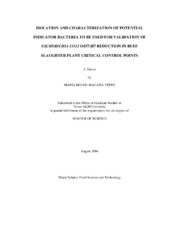| dc.contributor.advisor | Acuff, Gary | |
| dc.creator | Magana Yepez, Maria Belem | |
| dc.date.accessioned | 2005-11-01T15:51:23Z | |
| dc.date.available | 2005-11-01T15:51:23Z | |
| dc.date.created | 2004-08 | |
| dc.date.issued | 2005-11-01 | |
| dc.identifier.uri | https://hdl.handle.net/1969.1/2766 | |
| dc.description.abstract | Microbiological detection of foodborne pathogens is ineffective for monitoring critical control points (CCP) within a slaughter/processing Hazard Analysis and Critical Control Point (HACCP) system. Pathogens are usually absent from carcass surfaces and their uneven distribution makes it difficult to obtain a representative sample. However, microbiological testing can be applied within a HACCP plan to validate and verify the effectiveness of decontamination procedures designed to control hazards. With proper data collection, the reduction of an indicator group at a point in processing can indicate that a specific pathogen is being effectively controlled, especially when pathogen levels are too low to allow confirmation of process control, as they typically are in beef slaughter processing. Since E. coli O157:H7 has been shown to have some acid resistance, the ability of typical indicator organisms to accurately predict the reduction of this pathogen by carcass decontamination procedures has been a concern. Obtaining potential indicator bacteria from the same environmental reservoir as E. coli O157:H7 may provide non-pathogenic indicators with similar heat- and acid-resistance characteristics suitable for use in processing plant environments for validation and verification of carcass decontamination treatments within HACCP plans.
Potential indicator bacteria were isolated from hides of cattle at slaughter facilities in Arizona, Georgia, and Texas and compared with isolates of E. coli O157:H7 from the same locations to determine similarity in acid- and heat-resistance characteristics. After evaluation at 2 heating temperatures (55 and 65??C) and 3 pH levels (3.0, 4.0, and 5.0), it was determined that several potential indicator bacteria were slightly more resistant than E. coli O157:H7 to heating and acid treatment. The greatest reduction in numbers for E. coli O157:H7 and indicator bacteria occurred at pH 3.0 and temperature of 65??C. Counts of bacteria grown at pH 4.0 and 5.0 were not significantly different.
Testing indicated that several of the isolates from cattle hides would make good process control indicators since the indicator bacteria were reduced by heating or acid conditions at similar or greater rates when compared to E. coli O157:H7, providing an increased level of security that pathogens have been reduced in processing. | en |
| dc.format.extent | 517847 bytes | en |
| dc.format.medium | electronic | en |
| dc.format.mimetype | application/pdf | |
| dc.language.iso | en_US | |
| dc.publisher | Texas A&M University | |
| dc.subject | E. coli O157 | en |
| dc.subject | heat resistance | en |
| dc.subject | acid resistance | en |
| dc.title | Isolation and characterization of potential indicator bacteria to be used for validation of Escherichia coli O157:H7 reduction in beef slaughter plant critical control points | en |
| dc.type | Book | en |
| dc.type | Thesis | en |
| thesis.degree.department | Animal Science | en |
| thesis.degree.discipline | Food Science and Technology | en |
| thesis.degree.grantor | Texas A&M University | en |
| thesis.degree.name | Master of Science | en |
| thesis.degree.level | Masters | en |
| dc.contributor.committeeMember | Cisneros-Zevallos, Luis | |
| dc.contributor.committeeMember | Miller, Rhonda | |
| dc.type.genre | Electronic Thesis | en |
| dc.type.material | text | en |
| dc.format.digitalOrigin | born digital | en |


